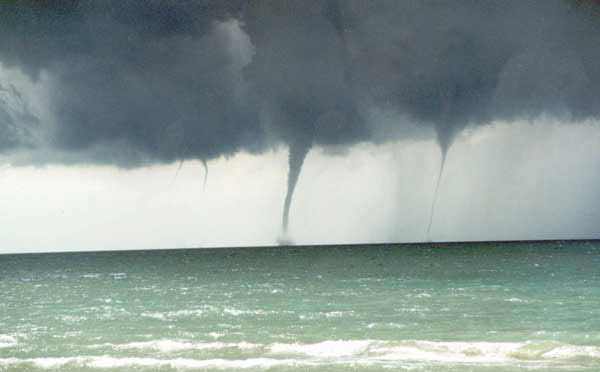A waterspout is a powerful columnar vortex that forms over water and typically resembles a funnel-shaped cloud. Some are associated with cumulus congestus, some with cumulonimbus clouds, and others with cumuliform clouds. A fair-weather waterspout’s life cycle has five stages. A prominent circular, light-colored disc with a larger, darker area around it at first appears on the water’s surface. A pattern of light-and dark-colored spiral bands emerges from the dark spot on the water’s surface after the formation of these coloured discs on the surface. Then, around the dark spot with what seems to be an eye, a dense ring of sea spray known as a “cascade” appears. The waterspout eventually transforms into an apparent funnel that leads from the water’s surface to the cloud above. The spray vortex can reach heights of several hundred feet or more, and as it moves, it frequently leaves a visible wake and a related wave train. The life cycle of the waterspout is finally completed as the funnel and spray vortex start to dissipate as the warm air inflow weakens.
Most waterspouts are weak, small rotating columns of air over water rather than sucking up water. Stronger variants, produced by mesocyclones, do occasionally exist, despite generally being weaker than their land-based counterparts.
Although they have been spotted in the Great Lakes, tropical and subtropical regions are where waterspout formation is most common. But, nine waterspouts were reported on Lake Michigan in the United States at once in 2012. Although they are rare, waterspouts have been observed in conjunction with lake-effect snow precipitation bands.
Tornadoes over water, also known as “tornadoes watersprouts” are formed from mesocyclones in a manner that is essentially the same as how tornadoes on land are formed in connection with severe thunderstorms. Tornadic waterspouts would also include a tornado that crosses from land to water. True tornadic waterspouts are consequently more uncommon than their fair-weather counterparts.

National Oceanic and Atmospheric Administration, Public domain, via Wikimedia Commons
Any object within 90 cm (1 yard) of the water’s surface, including fish of all sizes, frogs, and even turtles, can be lifted into the air, depending on how quickly the winds from a waterspout are whipping. Sometimes, a waterspout can pull small animals like fish out of the water and up into the cloud. Even if the waterspout stops rotating, the fish in the cloud can still be carried over land and tossed around by the wind until the cloud’s currents are no longer able to keep the fish in the air. People up to 160 km (100 miles) inland have reported seeing fish fall from the sky.
In the 18th and 19th centuries, it was a widely held belief among sailors that firing a broadside cannon volley dispersed waterspouts. Captain Vladimir Bronevskiy, among others, asserts that it was a successful tactic because he saw a phenomenon disappear in the Adriatic. The Mary Celeste was abandoned, and a waterspout has been suggested as the cause.
Watersprouts have long recognized as significant marine hazards. Watercraft, aircraft, and people are all in danger from stronger waterspouts. It is advised to stay well away from these phenomena and to always be alert by monitoring weather reports. When waterspouts are expected to move onshore or have already been sighted over coastal waters, the National Weather Services frequently issues special marine warnings or tornado warnings.




